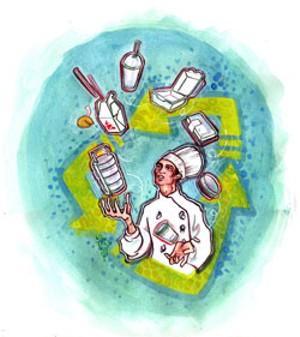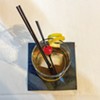Published June 24, 2009 at 5:26 a.m.
Paper or plastic? When customers arrive at a natural-foods store sans reusable sacks, the simple choice of a bag can be fraught with tension. Some shoppers ask for plastic through clenched teeth, wary of dirty looks from the Earth-friendly staffers. Some make excuses: “I’ve got to walk a mile home and need something with handles.” “I forgot my canvas bags in the car.”
That choice may be tricky, but it’s nothing compared with what restaurateurs go through when trying to select to-go containers. From eaters who want to chow a steaming burger and fries on a sunny park bench to those who couldn’t finish their sautéed sea scallops, nearly everybody gets food “wrapped up” at some point. And eco-conscious diners judge restaurants on their packaging. But when options include Styrofoam, aluminum, corn, bamboo and recyclable plastic, the decision is anything but easy.
At Handy’s Lunch in Burlington, a neighborhood diner, owner Earl Handy keeps customers happy with meaty “Texas” chili dogs and pancakes. When they’re ordered to go, he packs ’em in Styrofoam. “Our foam container has a recyclable triangle on it,” he points out. But that’s not the reason he chose them, and the Chittenden Solid Waste District doesn’t accept them. “Bottom line, it’s cheap,” Handy concedes.
He conjectures that buying lunch in Burlington can easily cost $15, and he’s proud that his customers can get a hot, hearty meal for less. “You can come here and get an $8.75 takeout lunch, because I’m not paying $1 per container,” Handy says. Plus, he suggests, inexpensive paper containers “are not going to hold up” to French fries and juicy toppings.
Foam aside, the father of twins is thinking about the environment. “Would I like to go more green? Absolutely,” Handy says. “Conserving gas, electricity and water is how I try to do it.” He says he’s happy to fill a travel mug with coffee for the same price, even if it’s bigger than his largest paper cup. And, by serving lunch in reusable plastic baskets lined with paper rather than on porcelain plates, he’s running the dishwasher less.
Clay Vagnini, aka “Big Fatty,” owner of the eponymous barbecue joint on Burlington’s Main Street, is convinced that his customers want their pulled pork piping hot. “I hate to say it, but Styrofoam with a lockdown lid is the absolute best for retaining heat,” he opines. “Paper simply has no insulating qualities at all.” When he knows a customer will be reheating the ’cue, Vagnini notes, he has his staffers forgo foam and pack the goods in oven-safe aluminum containers.
Although Vagnini and his staffers aren’t big on political correctness (don’t ask if the meat is local), the cook promises that he’s paying attention to the options. “We beat up on our vendors all the time,” Vagnini says. “We’ll use a recycled paper bowl in the shop; we use plastic baskets [lined] with paper, and all that stuff is eco-friendly. But people come in and they want to eat at the beach. It’s the convenience of takeout that kills you.”
Vagnini wishes that customers who “go off the deep end” about Fatty’s Styrofoam packaging had time to sit down with him to “go through the basic economics of what it takes” to run a restaurant.
Handy, too, notes: “You have to care about the environment … but there’s also a point where you have to do what’s economically right for your business.”
At some restaurants, it’s about more than balancing economics with eco-friendliness. At the upscale Pitcher Inn in Warren, for example, General Manager Ari Sadri says packaging options are limited by the restaurant’s off-the-beaten-track location: “To be honest with you, so much depends on what we’re able to get through our purveyors.”
For this reason, the inn uses functional aluminum containers with foil tops that are roomy and easily stackable. “I’d love to say we have a beautiful, fancy container,” Sadri says. “There are all of these esoteric considerations. Availability is a big one.”
Given the romantic setting and classy service of Burlington’s Trattoria Delia, a surprising amount of pasta and fritti misti heads out its door. “People will do takeout from here and have dinner on their boats,” says co-owner Lori Delia. When “The Sopranos” was still running new episodes, she recalls, “at the end of the season, you’d see this influx of people doing takeout.”
When they do, their goods are packed in the same foil containers used at The Pitcher Inn. Big orders are piled in reusable brown grocery bags stamped with the restaurant’s name. “It’s very simple. It’s very understated,” Delia says.
Although she and husband Tom have done cost comparisons on different styles of containers made of different materials, they haven’t been persuaded to change theirs. “It’s an interesting dilemma,” Delia says. “We stay with what we have because it works.”
For one thing, foil containers can safely sit under lamps to keep food hot until customers arrive to pick it up. They’re also easily stackable, are unlikely to leak or spill, and can be placed in the oven.
Places that don’t do much takeout have other options. Food and Beverage Director Chris Benjamin at Butler’s at The Essex says sated diners are sent off with their leftovers in eco-friendly bamboo containers. Need a spoon with that? Their to-go utensils are formed from potato starch.
The switch, a cooperative effort of the inn and the New England Culinary Institute, happened nearly two years ago as The Essex began pursuing green certification. “We probably don’t advertise it as much as we should,” Benjamin says, noting that even the “little sauce ramekins are biodegradable.”
Claire’s Restaurant in Hardwick is also leaning green, but its first choice for takeout packaging came with an unusual kind of “sticker shock.” “We started off by using switchgrass and something else that’s completely biodegradable,” Chef-Partner Steven Obranovich recalls. “The boxes arrived and said they were from China.” Not the best option for a place that prides itself on supporting local ag.
When the China-made containers run out, Claire’s will use a paperboard version endorsed by the Green Restaurant Association. But Obranovich acknowledges an even more sustainable possibility that many forget: containers from home. If he were to glance from his open kitchen and see a customer scraping leftovers into a Pyrex container, he would “applaud them,” the chef says. “The servers would be incredibly jazzed,” he adds.
Chef Brock Miller of Burlington’s Tilley’s, a member of the Vermont Business Environmental Partnership, feels the same way. “We would completely encourage that,” he says of the BYO possibility, then notes that the restaurant has taken numerous “green” steps of late. In addition to using lemon juice as a de-limer instead of toxic and expensive chemicals, switching to energy-efficient lighting, and starting a robust composting program, Tilley’s uses corn-based, compostable and biodegradable takeout containers. “Every day we learn about some new product or a new way of doing things to save water and energy,” Miller says.
At Claire’s and Tilley’s, the customer container option is a well-received hypothetical, but at Magnolia Bistro in downtown Burlington, it’s a reality. “We have a few customers who bring in a Tupperware and request we fill it,” says co-owner Shannon Reilly. “Reducing and reusing is something we’re big on.”
Luckily, that’s A-OK with Vermont Department of Health Restaurant Inspector Al Burns. “Our regulations don’t spell out that it has to be a certain kind of container,” he notes. Provided that nothing in the restaurant “becomes contaminated” through contact with a dish of unknown cleanliness — “Some people’s idea of washing is to rinse something with cold water,” Burns notes with a shudder — items from home are fair game.
Reilly and partner July Sanders have another clever way of reducing the number of containers they send out their door. When folks who work in or near Magnolia’s building get a garbanzo burger or steak sandwich to go, they’re offered a real plate. “They can take it up to the office and eat at their leisure. That’s worked for us,” Reilly says. “We haven’t noticed our dishes thinning out or anything.”
When Magnolia does pack up items to go, they’re placed in compostable Greenware, which is made from plant-based resin. One drawback? The containers aren’t designed to break down in a backyard compost bin. According to the line’s maker, Fabri-Kal, they’re meant for “actively managed municipal or industrial facilities” such as the Intervale or Vermont Compost Company.
Reilly says he chose not to use recyclable plastic — cheaper than his containers, but more eco-friendly than Styrofoam — because doing so would help support the oil industry. “We absorb the cost of [Greenware]. We feel like we’re doing the right thing,” he says.
And those eco-friendly containers aren’t nearly as pricey as some other restaurateurs seem to believe. Most of them guessed that switching containers would cost an extra 70 cents to $1 per piece. Magnolia’s largest boxes, at 9 by 9 inches, are 23 cents each — nearly double the cost of Styrofoam, true, but well below the estimate.
Gung-ho Reilly suggests that eateries can make green containers more affordable by reducing other costs. “Composting is less expensive than trash removal and recycling, so if you can get a functioning composting and recycling program, it saves you on your trash bill, which leaves you money to spend a little more on your containers,” he suggests.
Consumers who do a disdainful double-take when they see Styrofoam may need to ask themselves some tough questions: Are they willing to soak up slightly higher food costs so restaurants can afford the good stuff? Is sending each container to its proper resting place worth the trouble? Given our concerns about soil quality, water use and global warming, this conversation is certain to heat up.
The Green Issue
Used to be that if you wanted a green house, your choices were forest green, sage, mint julep or seafoam spray. Today, green houses are more about R-values, sustainably cut lumber and low-flow toilets. The green-building revolution may not be televised, but it has arrived in Vermont and is making headlines.
This week, Ryan and Susan Hayes share their blueprint for a greener footprint with their ambitious plans for an earth-friendly house; Ken Picard asks which houses are green and which ones are “greenwashed”; Kevin Kelley visits Middlebury’s Good Point Recycling to find out where our electronic trash goes; and Lauren Ober contemplates “upcycling.” Shelburne’s Joe Nusbaum takes a tiny house on the road, as Alice Levitt reports; Food Editor Suzanne Podhaizer takes on takeout — containers.
We’ve only got one planet. Let’s not waste it.
This is just one article from our 2009 Green Issue. Click here for more Green Issue stories.
More By This Author
Speaking of...
-

Q&A: Howard Fisher Delivers Meals on Wheels With a Side of Good Cheer
Dec 20, 2023 -

Video: Howard Fisher Delivers Meals on Wheels
Dec 14, 2023 -

Q&A: Alexis Dexter Rescued 57 Shelter Cats During the July Flood
Sep 13, 2023 -

Video: Two Months After the Flood, Alexis Dexter Rebuilds Kitty Korner Café in Barre and Continues to Rescue Cats
Sep 7, 2023 -

Video: Saying Goodbye to Burlington’s Penny Cluse Café
Nov 17, 2022 - More »
Comments
Showing 1-1 of 1
Comments are closed.
From 2014-2020, Seven Days allowed readers to comment on all stories posted on our website. While we've appreciated the suggestions and insights, right now Seven Days is prioritizing our core mission — producing high-quality, responsible local journalism — over moderating online debates between readers.
To criticize, correct or praise our reporting, please send us a letter to the editor or send us a tip. We’ll check it out and report the results.
Online comments may return when we have better tech tools for managing them. Thanks for reading.














































